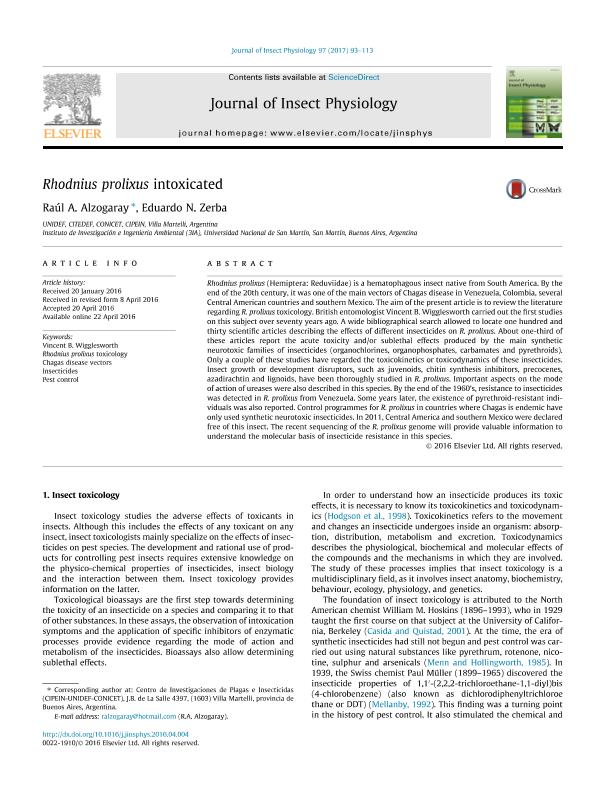Artículo
Rhodnius prolixus intoxicated
Fecha de publicación:
02/2017
Editorial:
Pergamon-Elsevier Science Ltd
Revista:
Journal of Insect Physiology
ISSN:
0022-1910
Idioma:
Inglés
Tipo de recurso:
Artículo publicado
Clasificación temática:
Resumen
Rhodnius prolixus (Hemiptera: Reduviidae) is a hematophagous insect native from South America. By the end of the 20th century, it was one of the main vectors of Chagas disease in Venezuela, Colombia several Central American countries and southern Mexico. The aim of the present article is to review the literature regarding R. prolixus toxicology. British entomologist Vincent B. Wigglesworth carried out the first studies on this subject over seventy years ago. A wide bibliographical search allowed to locate one hundred and thirty scientific articles describing the effects of different insecticides on R. prolixus. About one-third of these articles report the acute toxicity and/or sublethal effects produced by the main synthetic neurotoxic families of insecticides (organochlorines, organophosphates, carbamates and pyrethroids). Only a couple of these studies have regarded the toxicokinetics or toxicodynamics of these insecticides. Insect growth or development disruptors, such as juvenoids, chitin synthesis inhibitors, precocenes, azadirachtin and lignoids, have been thoroughly studied in R. prolixus. Important aspects on the mode of action of ureases were also described in this species. By the end of the 1960?s, resistance to insecticides was detected in R. prolixus from Venezuela. Some years later, the existence of pyrethroid-resistant individuals was also reported. Control programmes for R. prolixus in countries where Chagas is endemic have only used synthetic neurotoxic insecticides. In 2011, Central America and southern Mexico were declared free of this insect. The recent sequencing of the R. prolixus genome will provide valuable information to understand the molecular basis of insecticide resistance in this species.
Archivos asociados
Licencia
Identificadores
Colecciones
Articulos(UNIDEF)
Articulos de UNIDAD DE INVESTIGACION Y DESARROLLO ESTRATEGICOS PARA LA DEFENSA
Articulos de UNIDAD DE INVESTIGACION Y DESARROLLO ESTRATEGICOS PARA LA DEFENSA
Citación
Alzogaray, Raúl Adolfo; Zerba, Eduardo Nicolás; Rhodnius prolixus intoxicated; Pergamon-Elsevier Science Ltd; Journal of Insect Physiology; 97; 2-2017; 93-113
Compartir
Altmétricas




